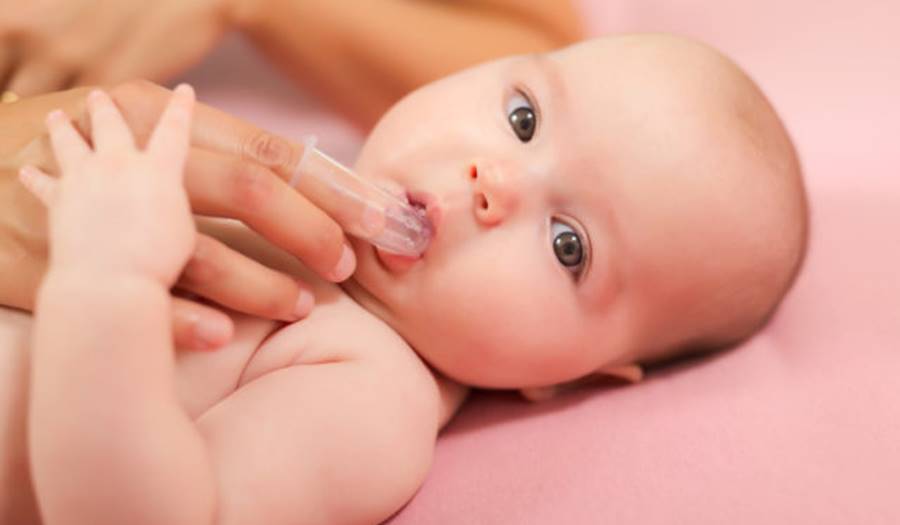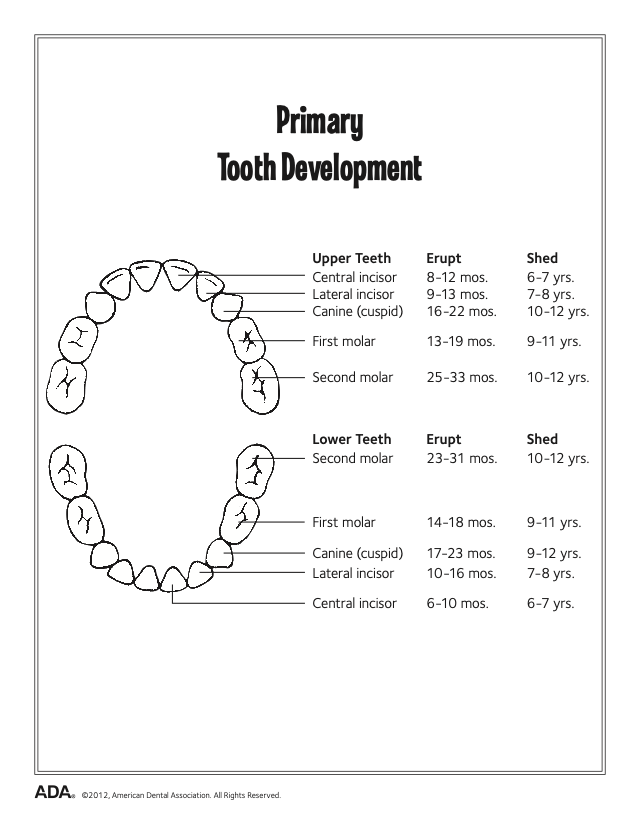
Dental Health
2/1/2021
KEEPING YOUR CHILD’S SMILE BRIGHT
As pediatric healthcare providers, we partner with dentists to monitor your child’s oral health. We watch for primary teeth to erupt, offer suggestions that help with teething, and provide fluoride in the office. We also are the first providers watching over your child’s teeth until you find a dental home. The AAP recommends you find a dental home for your child by age 1.
TOOTH ERUPTION
TOOTH ERUPTION
Most children are born without teeth. The exception is a natal tooth! A natal tooth is a tooth a child is born a tooth that develops in the first 30 days of life. This is extremely rare. More commonly children get their first teeth between 6-8 months. This is a range and we do have babies that can have a first tooth as early as 3-4 months or as late as 18 months!
This range of tooth erupting continues for the primary teeth as well as secondary teeth. You can see expected ranges below.

TEETHING
Teething is how we refer to the pain that babies feel when their teeth are erupting. The level of distress is dependent on your baby. Your baby may be fussier that usual, may have increased drooling, and may want to chew or bite on objects more than usually. But remember, drooling and chewing are developmentally normal and are important to learning to eat. Drooling and exploring objects with their mouth starts between 3-4 months and they do not always indicate teething.
Fever, rash, and diarrhea are often noted to be symptoms of teething, but they are not. If your baby has a temperature, there is another cause. Teething never elevates body temperature over 100.4 degrees. Your baby may get a rash around their mouth from extra drool, but they should not have a full body rash. Looser stool may be normal but not diarrhea which is more than 3 watery or loose stools per day.
To help your baby when they are teething you can offer:
- Gum massage with your finger or a finger toothbrush
- Teething toys
- Frozen pops of puree, breast milk, or formula
- Frozen fruit in a silicone feeder
- Teething/Biter biscuits or crackers
- A cold object: a frozen pacifier or spoon
- A frozen wet washcloth (take a corner of a washcloth and dip in water or formula, freeze for 15-30 minutes)
- Analgesic such as acetaminophen or ibuprofen (if over 6 months)
We caution you to avoid homeopathic preparations. Often these contain herbal supplements. The dosing of these supplements is not regulated and therefore you cannot be sure what dose they are getting. They often also contain Belladonna which is a neuro toxin. We also do not recommend amber necklaces. There is no clinical data to support these as being beneficial and these necklaces are a choking and strangulation hazard. And we also recommend avoiding numbing gels as these can decrease the gag reflex and can interfere with swallowing.

ORAL HEALTH
BRUSHING
Tooth brushing should actually start BEFORE your child has teeth! Using soft washcloth, a finger brush or a silicone brush on their gums helps keep your baby’s mouth clean. It also helps them get use to brushing. Building a habit from a young age can help increase cooperation with older babies and toddlers.
Once your baby has teeth, brush your child’s teeth using a soft bristle toothbrush twice a day. You may use fluoridated toothpaste once your baby has teeth. It is important to only use a small amount of toothpaste, the size of a grain of rice. This is a safe amount for a baby in case they swallow the toothpaste. You should brush each tooth for 5-10 seconds. Make sure to lift their upper lip to help clean the top teeth.
Once your child is 3 years old continue brushing with a soft bristled toothbrush twice daily. Toothpaste should now be applied to the brush in a pea sized amount. Your child should be able to spit extra toothpaste out of their mouth by this age.
After age 6, children can start brushing their teeth on their own with supervision. A parent should be present to make sure they are doing a full and complete job, brushing every tooth and surface for a total of 2 minutes. If your child has persistent plaque, they could start using an electric toothbrush at this age.
Brush teeth twice a day, in the morning and right before bedtime. It is important to remove any plaque and bacteria before bed. Because you have less saliva in your mouth when you are sleeping, it is easier for bacteria to be active in your mouth creating more plaque and potential tooth decay. Rotate the section of teeth you start with to make sure one section doesn’t receive more or better care than another section of teeth. After brushing, rinse the brush well with water, store upright, and allow the brush to air dry. A toothbrush should be replaced every 3 months, when it shows signs of wear (which will happen more quickly than with adults), or if your child has been ill.
See here for dental product recommendations.

FLOSSING
Once Flossing should begin once your child has teeth that are touching. Flossing someone else’s teeth, especially a non-cooperative child can be challenging. Floss picks can make the job easier or try tying floss into a circle shape to help stabilize it on your fingers. You can also consider a water flosser if your child would tolerate that better.
TIPS FOR BRUSHING
For many babies and toddlers, toothbrushing can be distressing. We recommend these tips to help brushing be successful:
- Start early (before teeth erupt)
- Let your child play or brush with the toothbrush before you brush their teeth
- Let your child pick out a toothpaste flavor between two options. Giving a child control over part of the process can be very helpful
- Give them a toy to occupy their hands
- Let them brush your teeth while you brush their teeth
To aid you in brushing their teeth you may need to hold your child. If they struggle during toothbrushing try:
- Different locations including the floor, changing table, or highchair
- Stabilize their head with your hands or knees to prevent moving (for a child who is not cooperating, this may take 2 adults)
- Different positions such as sitting or lying. Lying is often easier. It gives you a better view of their teeth. Also mouth muscles are more relaxed in this position which can make it easier to brush.
CHALLENGES
Children with disabilities can have extra challenges to their oral health. They can have motor skills or challenges that can make brushing more difficult. They may be on medications that reduce saliva in their mouth there by increasing the risk of tooth decay. Some children require special diets that may increase the risk of decay. If their disability requires frequent specialist visits, surgeries or testing, they may fear the dentist. It may also be harder to find a dentist that sees children with disabilities. A plan to provide oral care accounting for your child’s individual needs should be addressed when meeting with your health care team including their specialists, any involved therapists, their pediatrician, and a pediatric dentist.
FLUORIDE
Fluoride is a naturally occurring mineral that helps fight cavities by making it harder for mouth bacteria to produce acid that damages teeth. Fluoride also helps rebuild tooth enamel. Tooth enamel is the hard coating that covers our teeth. It is the strongest substance in our bodies!
Some communities provide fluoride via water. If your community does not provide this or you have well water, we recommend your child starts fluoride drops at 6 months. As they get older, they can switch to a chewable version. Any toothpaste you use should contain fluoride.
DENTAL VISITS
The American Academy of Pediatrics, the American Academy of Pediatric Dentists, and the American Dental Association, all recommend finding your child a dentist by age 1. Dental visits are important for promoting good oral health. These visits can also recognize problems and treat these problems earlier. We recommend routine dental visits every 6 months.
If you need to find a dentist, please ask our office for local recommendations or you can consult resources: the American Academy of Pediatric Dentist, America’s Pediatric Dentists, or Insure Kids Now.
DENTAL ISSUES
TOOTH DECAY AND CAVITIES
Tooth decay is one of the most common chronic childhood diseases. By age 2, 10% of all children have had a cavity. That increases to 28% by age 3 and 50% by age 5! If untreated, tooth decay can progress quickly causing teeth to breakdown.
Regular dental visits help catch tooth decay early. You can also monitor your child’s teeth at home. Healthy enamel looks white, smooth and shiny and it feels hard. Early signs of tooth decay can be white spots on the teeth. Later signs of tooth decay and caries (cavities) can be yellow, brown, or black spots. Sometimes you can see a hole in the tooth. Cavities can also occur between teeth where it is harder for us to see. Dentist will do x-rays during routine dental visits to check for cavities between teeth.
To help prevent cavities you can do the following:
- Brush twice daily
- Floss daily once teeth are touching
- Attend regular dental visits every 6 months
- Use fluoride toothpaste
- Avoid sticky sugary foods (toffee) or sticky carbohydrate heavy foods (such as crackers, fruits leathers, gummy snacks) that sit on the teeth for long periods of time
- Avoid sugary beverages
- Offer only water between meals
- Never give your baby a bottle of milk or a sugary beverage to be kept in the crib during nap or bedtime.
“Bottle-mouth syndrome” is tooth decay that occurs due to prolonged exposure to milk or a sugary beverage. This prolonged exposure to sugary beverages allow bacteria to produce acid that break down teeth. Bottle-mouth syndrome generally results in teeth with decay and cavities requiring removal. In young children, this means a surgery with anesthesia.
This can occur in babies who are given a bottle to bring to bed containing milk or a sugary beverage. NOTE IT IS NOT SAFE FOR A BABY TO BE GIVEN A BOTTLE UNSUPERVISED IN THEIR CRIB NO MATTER WHAT IT CONTAINS. Older children who are thirsty during the night can be provided water if needed.
Bottle-mouth syndrome can also occur in children who carry a sippy cup or bottle of milk or juice around during the day or in children who graze on food all day. Milk or juice should only be served with meals. Only water should be served between meals.
Your child should also not be allowed to graze all day. Grazing provides bacteria with unending supplies of food and increases the risk of tooth decay. Your mouth needs to be able to reset to the correct pH after meals. We recommend 3 meals a day and 2-3 scheduled snacks.
PACIFIERS AND THUMB SUCKING
Sucking is a natural method of soothing. The American Academy of Pediatrics encourages pacifier use though 6 months of age to help reduce the risk of SIDS. But prolonged use of a pacifier or prolonged thumb sucking can affect tooth and jaw development. Prolonged use can result in changes to bite (anterior open bites or posterior crossbites), misalignment of teeth, and it can cause the front teeth to protrude forward. Prolonged use can also restrict growth of the haw causing the upper jaw to narrow. And as discussed in our starting feeds post, it can cause incorrect swallowing patterns and incorrect tongue positioning during feeds. These changes can be reversible if done earlier enough but after age 3-4 they can be more permanent changes.
We recommend stopping the pacifier after 6 months. If this is not feasible, we recommend providing a pacifier for sleep ONLY after age 6 months. This means only using it during nap and bedtime. Thumb sucking can be harder to combat because you can’t take it away. If you can catch it early and try to replace that habit with a pacifier, you will be able to wean easier in the future. If not, we recommend attempting to disrupt thumb sucking by age 3.
Dental care is an important component to your child’s overall health. If you have any questions about oral health, tooth development, or finding a dentist, please do not hesitate to ask your healthcare provider.
Children’s Health Care of Newburyport, Massachusetts and Haverhill, Massachusetts is a pediatric healthcare practice providing care for families across the North Shore, Merrimack Valley, southern New Hampshire, and the Seacoast regions. The Children’s Health Care team includes pediatricians and pediatric nurse practitioners who provide comprehensive pediatric health care for children, including newborns, toddlers, school aged children, adolescents, and young adults. Our child-centered and family-focused approach covers preventative and urgent care, immunizations, and specialist referrals. Our services include an on-site pediatric nutritionist, special needs care coordinator, and social workers. We also have walk-in appointments available at all of our locations for acute sick visits. Please visit chcmass.com where you will find information about our pediatric doctors, nurse practitioners, as well as our hours and services.
Disclaimer: this health information is for educational purposes only. You, the reader, assume full responsibility for how you choose to use it.








